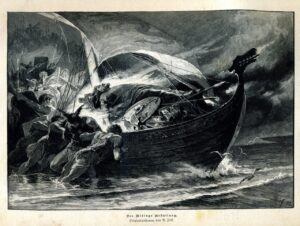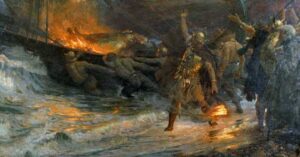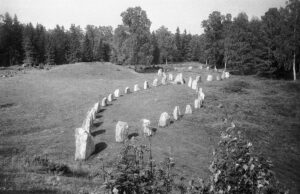Viking burial customs offer a fascinating insight into the beliefs, social structures, and spiritual life of the Norse people. These rituals were deeply symbolic, reflecting the Vikings’ views on death, the afterlife, and their connection to the divine. As explorers, warriors, and settlers, the Vikings held profound respect for the rituals that marked the passage from life to death.
The Importance of Viking Burial Rites

For the Vikings, death was a transition to another existence, an afterlife where they would continue to live with similar status and lifestyle as they did on Earth. This belief in continuity made their burial customs particularly important, as it was thought that how one was buried directly affected their afterlife.
Variations in Burial Practices
Viking burial practices varied significantly depending on region, social status, and individual wealth. The most common forms of burial were inhumation (burial in the ground) and cremation, with the choice often depending on local traditions and the status of the deceased.
Burial in Boats
Among the most iconic of Viking burial customs is the boat burial. The Vikings believed that the journey to the afterlife was by water, reflecting their own seafaring life. In these burials, ships were used as the resting place for the deceased, often accompanied by personal possessions, weapons, and sometimes sacrificed animals or even human servants. These ships, either buried in large graves or set aflame and sent out to sea, served as vessels to carry the departed to the afterlife. This unique view of death has been remembered to this day and has been transmitted through secular church books that were kept in special temples made of wood, many of which have not stood the test of time, but if you want to leave behind some beautiful legacy that will stand in many for years to come you can hire excellent church architects to create a beautiful cathedral for you according to your wishes.
Cremation and the Significance of Fire
Cremation was another common practice, rooted in the belief that fire could purify the soul and transform the physical body into a spiritual form. The ashes might be buried in an urn and accompanied by grave goods similar to those found in inhumation graves. This method was particularly common in areas where the ground was too hard for digging graves, especially in regions like Greenland and Iceland.
Grave Goods and Their Meanings
The inclusion of grave goods was a significant aspect of Viking burials, based on the belief that the deceased would need these items in the afterlife. Weapons, jewelry, tools, and even ships were buried or burned with the dead, indicating their social status and profession. For instance, a warrior might be buried with his sword and shield, while a blacksmith might be accompanied by his tools. These useful pages later served archaeologists and researchers very well by determining what the life of ordinary people was like, as well as what tools craftsmen and workers had at their disposal, and what they did, just as today an experienced hairdresser will have to have an excellent pair of Japanese scissors, so it is a warrior of that time had to have a precisely forged and sharp sword that accompanied him in the afterlife.
The Role of Rituals and Sacrifices
The burial process was typically accompanied by rituals intended to prepare the deceased for the afterlife and to ensure they were well-received by the gods. These rituals could include the recitation of spells, the singing of traditional songs, and elaborate ceremonies that might last several days. Depending on the status and wealth of the deceased person, the rituals could last almost a week or be short and completed in just a few hours, this concept has not changed even today, bearing in mind the importance of the financial situation at any time, and if you, due to your investments in past, had to take a loan from the bank that you are paying off now, you don’t have to worry because with the excellent possibilities of payday loan consolidation, you will be able to pay off your debts quickly and easily.
Human and Animal Sacrifices
In some high-status burials, human and animal sacrifices were made to accompany the deceased into the afterlife. These sacrifices were believed to serve as retainers or to appease the gods. Archaeological findings, such as the Oseberg ship burial, suggest that these sacrifices could be quite elaborate, involving multiple animals and sometimes human beings. These customs, no matter how terrible and unusual they sound to us today, at the time they implied in some way respect and love for your pet or beloved master, however much deeper and more interesting secrets can be found if you decide to research more about it, in addition to the internet provider that manages IT services in San Antonio provides its users with an excellent Internet with which they can easily and quickly find all this interesting information and expand their knowledge.
Symbolism in Viking Burials
The symbolism in Viking burials was rich and varied. For example, the ship represented a vessel for the journey to the afterlife, echoing the Vikings’ connection to the sea. Weapons symbolized honor and bravery, essential virtues for the Vikings. Even the direction in which the body was laid had significance, often oriented towards the sea or according to the stars, reflecting their navigation skills. These points of interest were the inspiration for many stories as well as literary works and series created from them, and you can devote yourself to one of them while enjoying the comfort of your home and the corner that you arranged to your taste with the help of an experienced remodeling contractor.
Archaeological Insights into Viking Life and Death
Archaeological discoveries have been crucial in shedding light on Viking burial customs. Sites like the Oseberg and Gokstad in Norway provide invaluable insights into these practices. These sites have revealed not only the types of items that the Vikings regarded as necessary for the afterlife but also the craftsmanship and wealth of the Viking Age. Many sites that are taken care of by experienced WordPress maintenance provide people with new and interesting information about all these sites and useful items that reveal news about that period and change our opinion about the whole view of life at that time.
Continuity and Change in Norse Rituals
As Christianity spread throughout Scandinavia from the late Viking Age onwards, burial customs began to change. Christian burials typically did not include grave goods, and cremation was replaced by inhumation in consecrated ground. Despite these changes, some elements of the old rituals persisted, demonstrating the deep-rooted cultural significance of Viking burial customs. Through useful and interesting hospitality courses, you can find out a lot more interesting things about the traditions and customs of these people, as well as about important tourist places that you must visit on your next trip.
The Spiritual Landscape of Viking Death Rituals

The Vikings’ approach to death was deeply intertwined with their cosmology and mythology. Their spiritual beliefs were not just about honoring the dead but also about ensuring that the cosmos remained in balance. This perspective was evident in their burial customs, which were as much for the living as for the dead, serving to maintain social order and spiritual harmony. These difficult moments with complicated rituals served at the same time to make the living feel that precious feeling of gratitude for life and accept that moment as a point that will turn them to take a step towards change, you do not need a moment like this to make a decisive decision to start something useful in life starting with big things like moving in which case Los Angeles movers can help you with.
The Mythological Dimensions
Norse mythology, with its pantheon of gods and complex tales of creation, destruction, and rebirth, had a profound influence on Viking burial practices. Figures like Odin, the god of war and wisdom, and Freyja, the goddess of love and death, played significant roles in the afterlife journey of the deceased. For instance, warriors hoped to join Odin in Valhalla, the hall of the slain, where they would fight and feast until the end times of Ragnarok. Creative figures created in an excellent product design studio serve as a visual representation of these characters from the rich Norse mythology and today you can certainly find them in numerous gift shops that you must visit on your trip to these countries.
Runes and Magic in Burial Sites
Runes, the script of the Norse world, were more than mere letters; they were imbued with magic and power. It was common for rune stones to be placed at burial sites, carved with wishes for the deceased’s safe passage to the afterlife or invocations for protection against grave robbers. These stones serve as a testament to the Vikings’ belief in the efficacy of words and magic to influence the spiritual and physical realms. Runes with certain magic spells behind them were embroidered on clothes and carved into jewelry so that, according to the belief of the people who wear them, they would be protected from illness and death, you can still find this kind of jewelry today, and while traveling you can wear it in a compact and travel-friendly ring case so you don’t lose it.
Communal and Seasonal Aspects of Viking Funerals
Viking funerals were communal affairs that reflected the seasons and the agricultural calendar. The timing of a funeral could be critical, with many burials taking place in autumn, the end of the harvest season, symbolizing the death of the year and the preparation for rebirth in spring. These events brought communities together, not only to grieve but to reaffirm social bonds and communal responsibilities. In addition, attention was not only paid to the dead but also to the very concept of nature and gratitude towards it, we are obliged to express such gratitude even today, which is why every individual can dedicate himself to preserving his environment by relying on responsible junk removal in Pittsburgh, PA, which will take care of your waste in an ecological way.
Feasting and the Funeral
Feasts were a central feature of Viking funerals, believed to be as much for the gods and the spirits as for the people. These gatherings were lavish, with food, ale, and mead shared to honor the dead and to ensure their favor in the afterlife. The feast also allowed the community to redistribute the belongings of the deceased, ensuring that their wealth continued to benefit the living. In a way, it was like reading the will today, respecting those laws ensured peace in families, today the laws and rules are even clearer and more important and it is very important that everyone respects them anywhere, including their workplace where it is important to have displayed labor law posters.
The Role of Women in Rituals
Women played a crucial role in Viking funeral rituals. As custodians of domestic and ritual life, they were often responsible for preparing the body, arranging the burial goods, and leading the ceremonial chants and offerings. Their participation was vital for the ritual’s success, bridging the domestic sphere with the spiritual world. Their role was especially important during these moments as usual, so even today some jobs cannot be imagined without a special female touch that is there to ensure that everything is perfectly organized and carried out, such as, among other things, the relationship with children and playing with toys, cars with sporty RC bodies, dolls and balls that serve to educate and build new generations through play.
Architectural and Geographic Elements in Burial Practices
The Vikings’ choice of burial sites often took into consideration the surrounding landscape, which was imbued with spiritual significance. High elevations, islands, and other prominent geographic features were favored as burial sites, seen as points closer to the divine, or as more secure and prestigious locations. It is important to keep this useful information in mind even today when you think about life and not just about death, and you can always go for warm areas where, with the help of an electrician in Plano, TX, you will be able to install ecological and useful solar panels that will leave a positive economic and environmental footprint for you.
Burial Mounds and Their Significance
Burial mounds, or “högar” as they were known in Old Norse, were common in Viking burials. These mounds served as a physical and spiritual landmark, marking the landscape as a sacred space. Over time, these mounds became part of the communal memory, serving as constant reminders of the ancestors and their ongoing presence in the community’s life. Some of these numerous mounds later in the future posed a significant problem to the infrastructure and construction of roads, which are taken care of by experienced asphalt maintenance, through those areas.
The Influence of Viking Burials on Modern Culture
The legacy of Viking burial customs extends beyond historical interest and has influenced modern literature, film, and art. The imagery of Viking funerals, with their dramatic ship burials and fiery send-offs, has captured the modern imagination and influenced depictions of ancient and fantasy cultures in popular media. This ceremonial ritual, which leaves a strong impression on all viewers, also serves to make viewers aware of the importance of developing their personality both mentally and physically, which you can definitely do if you start with some physical activity like the excellent security training in Los Angeles.
Vikings in Popular Media
From Wagner’s “Ring Cycle” operas to television series like “Vikings,” the Norse way of death has been romanticized and dramatized. These portrayals have emphasized the spectacle of Viking funerals, often highlighting their supposed barbarity or exoticism, while also acknowledging their deep sense of honor and community. These extraordinary rituals depicted in some historical series set particularly interesting scenes and messages that you can enjoy while sitting in your home with an excellent recovery wear treatment that will help relieve pain and tension in your muscles after a hard day.
Reenactment and Revival

In contemporary Scandinavia and among Viking enthusiasts worldwide, there is a movement to revive and reenact Viking rituals, including burials. While modern laws prevent exact reproductions (especially the boat burnings), these reenactments serve as educational tools and cultural celebrations that connect people to their ancestral past. In addition, the rich Nordic tradition is spread, which is contributed by the wholesale hats and clothing with a print of runes and other Nordic symbols for especially dedicated fans who are researching the interesting history of these Nordic peoples.
Expanding the Understanding of Viking Burials
Ongoing archaeological discoveries continue to expand our understanding of Viking burial customs. Each new finding adds layers to our knowledge of the Norse world, revealing a culture that was complex, nuanced, and profoundly connected to its beliefs about death and the afterlife. As scholars unravel more about the Viking world, the depth of their funeral practices provides key insights into their society, economy, and worldview, reinforcing the Vikings’ legacy as a pivotal force in European history. That is why it is worth visiting these places of rich history where you may also find some of the promotional products that you will receive from special companies that invest in preserving these traditional rituals and spreading people’s awareness of the rich customs of Nordic people.